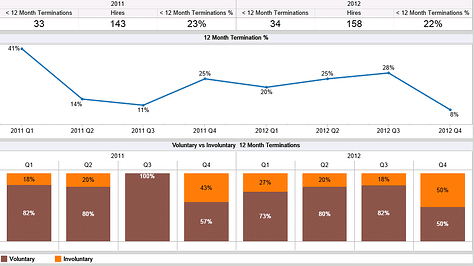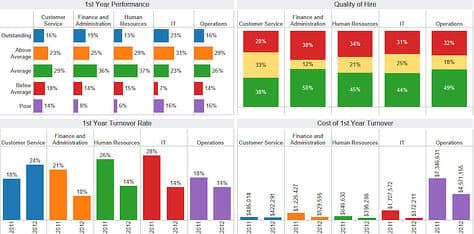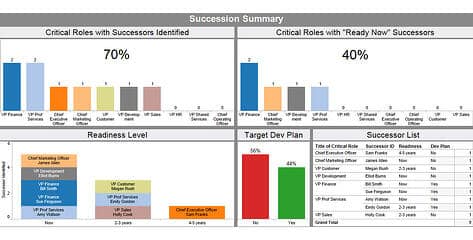Let’s look at one of our healthcare clients and how they benefit from people analytics. This client delivers patient care in hospitals and residences, conducts healthcare research, and provides education programs for healthcare providers, patients, residents and families.
Strategic HR
Like most organizations, this one has many moving parts on the people side of things. With over 2000 employees, there are categories of full-time, part-time, and contract employees, unionized and non-unionized employees, and hundreds of volunteers. Because they are in healthcare, the organization is no stranger to data and metrics. And the Director of HR wanted to understand people data at a deeper, more strategic level. To do this, the Director embarked on a risk-free trial of a HR analytics software.
Identifying objectives
To start, the people analytics partner facilitated a session with the HR team focused on ‘Articulating Objectives and Outcomes’. At this meeting, the HR director assembled key stakeholders including the VP of HR, and the group worked together to identify and articulate key priorities. These shaped the initial focus of the people analytics approach.
Four key objectives identified:
- First Year Turnover / Retention: The group sought to understand turnover by segment. Also, they wanted to slice/dice the data across the myriad of variables. These included age, gender, tenure, location, hiring manager, recruitment source, experience, training, qualifications, and performance.
- Absenteeism / Sick Leave: They also needed to understand where the organization stood in terms of absenteeism and sick leave. This included comparing the results to benchmarks and assessing whether internal assumptions held true or not.
- Talent Management / Succession Planning: The organization’s board wanted the ability to identify and develop leaders. And given the aging workforce and the large pool of eligible retirees, they had concerns about executive and senior management succession. A priority emerged to develop a view of succession, including key positions, percent of successors identified, and percent ready now. This data would support that.
- Communicating with Executives, Clients and Partners: HR sought a way to communicate more effectively, strategically, and in a language and format to resonate with each audience. The desire to change the perception of HR from operational to strategic partner also factored into the approach. People analytics is a means to visually tell the people story so that the story sticks. Additionally, it is a way to generate an approach of shared ownership and collective problem solving.
Asking the right questions
After identifying objectives, the next step involved asking these questions:
- What data do we have
- What additional data and metrics do we need to fully understand this area
- Who currently owns the data and metrics we need, and finally,
- What connections can we make across data sets to achieve clarity and insight around the objectives
The results: people analytics in action
Let’s take 2 of these objectives, First Year Turnover and Succession Planning, and see how people analytics immediately enhanced understanding. In addition, these analytics continue to motivate data-driven decision-making at the organization today.
First Year Turnover / Retention
As a result of uploaded and connected data, HR can now slice and dice it to answer key questions about turnover and retention. And in this example, specifically identify the segments where first year turnover is an issue. The inclusion of recruitment data and compensation data also supports quantifying first year turnover costs.
Sharing this with executives and key stakeholders has surfaced a shared ownership of problems. For example, there is collective viewpoint and turnover is no longer perceived as solely an HR issue. HR now folds in additional data as needed. This includes performance, employee satisfaction, learning, and absenteeism and sick leave data to bolster understanding of the first year experience.
Automation of a 30-day recruitment and onboarding survey and a 90-day check-in with new hires is in development. And with First Year Turnover Dashboards that highlight key information and business challenges, HR can clearly communicate the first year turnover story. In addition, they can recommend targeted action to reduce turnover among the affected groups.


Talent Management / Succession Planning
Recognized as a top priority at the Board level, HR sought to speak confidenly about plans for talent management and succession planning. By uploading succession, learning and development data, and connecting it to other data, HR can access important dashboard views. They can also view important data that could simply not be accessed before.
Information in one place is of immense value to the team. Because the dashboards present critical information visually and in a way that is clear and concise, it certainly makes it easier for key messages to stick. Using the dashboards as a springboard to discussion, HR keeps communications focused on objectives and can drive business-focused discussions and outcomes. Some of the key dashboards they leverage include:
- Retirement eligibility dashboard (age-driven)
- Dashboards focused on key jobs and impacts of current eligible retirees and upcoming eligible retirees
- Dashboards highlighting learning investments and leadership programs. They link programs to outcomes such as turnover, satisfaction, performance, etc.
- Succession planning dashboard with critical positions, successors and readiness level clearly illustrated. This provides clear and credible communication and action planning
An example of a Succession Summary Dashboard looks like this:

Conclusion
Clearly articulating objectives and outcomes and focusing people analytics towards these, HR Leaders demonstrate their value to the business. And with data-driven insights and visually impactful HR dashboards, HR has the confidence and the means to be more strategic. Consequently, today, they drive meaningful conversations focused around imperative business objectives and outcomes.
If you’re exploring to data-driven decision making for your HR organization, HireRoad can help. We work with clients in a variety of industries to elevate HR as a strategic business function. Talk to us and learn how we can help you elevate your business.